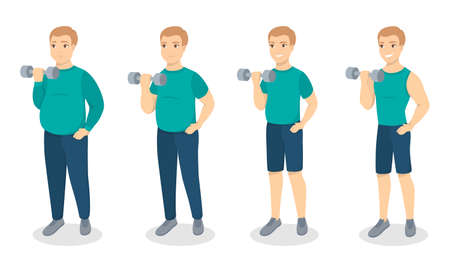Introduction: The Rise of Home Fitness in Modern American Life
In recent years, home fitness has taken center stage in the lives of many Americans, reflecting shifts in both lifestyle and living arrangements. The fast-paced rhythm of modern life, coupled with the trend toward smaller urban apartments and townhomes, has made it increasingly challenging for people to carve out time—and space—for traditional gym routines. As a result, more individuals are embracing the flexibility and accessibility that home workouts offer. Low-impact exercise routines, in particular, have surged in popularity due to their adaptability; they require minimal equipment, reduce the risk of injury, and can be performed comfortably in compact living rooms or bedrooms. This evolution in fitness culture is not just about convenience—its about creating sustainable habits that fit seamlessly into busy schedules without sacrificing health and well-being. Today’s Americans are redefining what it means to stay active, making home fitness a cornerstone of everyday wellness.
Designing Your Home Fitness Zone — Making the Most of Small Spaces
Living in a city apartment or a cozy suburban home doesnt mean you have to sacrifice your fitness goals. With some thoughtful planning and creative solutions, you can transform even the tiniest corner into an effective workout zone. Whether you’re squeezing in exercise between Zoom meetings or fitting movement into family time, maximizing limited space is all about flexibility and innovation.
Tips for Maximizing Your Space
- Moveable Furniture: Opt for lightweight chairs, folding tables, or rolling storage units that can be easily rearranged or tucked away when it’s time to work out.
- Storage Hacks: Use under-bed bins, over-the-door racks, or wall-mounted shelves to keep fitness gear organized and accessible without cluttering your living area.
- Dual-Purpose Gear: Invest in equipment that serves more than one purpose—think resistance bands, adjustable dumbbells, or a yoga mat that doubles as a meditation spot.
Smart Space Solutions at a Glance
| Challenge | Creative Solution |
|---|---|
| No dedicated workout room | Create a “pop-up” gym using portable mats and collapsible equipment in your living room or bedroom. |
| Limited storage | Choose stackable weights and hang resistance bands on hooks behind doors or inside closets. |
| Tight schedules | Keep a small basket with essentials like water bottles, towels, and jump ropes ready for quick access anytime. |
| Multi-use spaces | Select furniture that doubles as fitness gear, such as an ottoman for step-ups or a sturdy chair for tricep dips. |
Making Fitness Fit Your Lifestyle
The key is adaptability. By integrating storage hacks and multi-functional pieces into your daily environment, you can create a flexible fitness zone that supports low-impact routines without interrupting your regular home life. Remember: it’s not about having the perfect space—it’s about making the space you have work for you.

3. Low-Impact Workouts That Pack a Punch
When it comes to staying fit at home, you don’t need tons of space—or high-impact moves—to see real results. In fact, low-impact workouts are gaining serious traction across the U.S., especially for people living in apartments, condos, or homes with limited room. These routines are easy on your joints while still delivering powerful benefits for strength, cardio health, and flexibility. Here’s how you can make the most out of every square foot without worrying about noisy jumps or complicated equipment.
Pilates: Core Power Without the Noise
Pilates is a superstar for small spaces and busy lives. With a focus on controlled movements and deep core engagement, Pilates routines can be done using just a mat. You’ll build strength, improve posture, and boost flexibility—all while keeping your body aligned and protected from impact. Many Americans love Pilates because it requires minimal gear and delivers visible toning results without ever having to leave your living room.
Yoga: Flexibility Meets Mindfulness
Yoga is another low-impact favorite that fits perfectly into tight schedules and smaller rooms. Whether you’re into power yoga for a sweat session or prefer gentle flows for stress relief, all you need is enough space to stretch out your mat. Yoga helps increase flexibility, balance, and even cardiovascular health when practiced regularly. Plus, it brings a dose of calm to your day—something everyone could use in today’s fast-paced world.
Resistance Bands: Small Tools, Big Gains
If you’re looking to up the intensity without adding bulk or noise, resistance bands are your new best friend. They’re affordable, take up almost no space, and can mimic the challenge of heavy weights. Use them for rows, bicep curls, squats, or glute bridges—all without risking damage to your floors or making a racket. Resistance bands offer a safe way to build muscle and ramp up your heart rate right in your living room.
Bodyweight Circuits: No Equipment Needed
Don’t underestimate the power of classic bodyweight circuits! Moves like squats, lunges, push-ups, planks, and mountain climbers deliver a full-body workout that burns calories and builds strength without ever leaving the ground. These exercises are ideal for apartment dwellers or anyone trying to squeeze in fitness between work calls—no gym membership required.
Low Impact, High Reward
The key to these workouts is their adaptability—they’re gentle on joints but tough on results. By mixing and matching Pilates flows, yoga stretches, resistance band drills, and bodyweight circuits, you can create endless combinations tailored to your schedule and space constraints. Whether you have ten minutes or an hour to spare at home, these low-impact options prove that effective fitness doesn’t have to mean high impact or high maintenance.
4. Time-Saving Strategies for Busy Lifestyles
In the whirlwind of American work and family life, carving out time for fitness often feels impossible. But you don’t need hours at the gym to stay active—short, structured routines can be seamlessly woven into even the most hectic schedules. Whether your mornings start with a flurry of emails or your evenings end with helping kids with homework, integrating low-impact workouts into small pockets of your day is both practical and powerful.
How to Fit Fitness Into Your Packed Schedule
The key is to choose efficient routines that require minimal space and zero setup. Think bodyweight circuits, yoga flows, or resistance band exercises—workouts you can do in your living room, bedroom, or even next to your desk. Consistency trumps duration; even 10-20 minutes daily delivers results when done with intention.
Sample 10-20 Minute Workout Options
| Time Slot | Workout | Description |
|---|---|---|
| Morning Kick-Start (10 min) | Dynamic Stretch & Core Circuit | Wake up muscles with gentle stretching, then cycle through planks, glute bridges, and standing marches for a full-body boost. |
| Lunch Break (15 min) | Bodyweight Strength Blast | Rotate squats, push-ups (knee or wall), and alternating lunges; add step-ups using a sturdy chair if space allows. |
| Evening Wind-Down (20 min) | Yoga & Mobility Flow | Melt away stress with child’s pose, cat-cow stretches, spinal twists, and gentle hip openers—perfect for relaxing before bed. |
Pro Tips for Staying Consistent
- Set calendar reminders for your workout times just like any other meeting.
- Lay out workout clothes the night before for morning sessions.
- If you’re working from home, sneak in movement during conference calls—try calf raises or seated leg lifts under your desk.
Adapting these quick routines isn’t just about saving time—it’s about prioritizing well-being amid the bustle of American life. Whether you rise early or wind down late, there’s always a way to move more and feel better right where you are.
5. Tech Tools & Trends: Virtual Classes and Smart Home Fitness
In the age of smart technology, home fitness has evolved far beyond DVDs and basic YouTube tutorials. American households are embracing innovative tech to transform limited spaces into personalized gyms—and it’s easier than ever to keep workouts effective and enjoyable, even with a jam-packed schedule.
Spotlight on Popular Fitness Apps
Apps like Peloton, Apple Fitness+, and Nike Training Club have become household names across the U.S., offering a vast library of low-impact routines that require minimal space. These platforms feature motivating trainers, real-time feedback, and community-driven challenges. Their adaptive programs can fit everything from a quick 10-minute stretch before work to a calming yoga flow after a long day.
Wearable Devices: Your Personal Coach
Wearables—think Apple Watch, Fitbit, and Garmin—are game-changers for tracking progress without cluttering your living room. Americans love their instant stats: heart rate, calories burned, and reminders to stand or move. These devices sync seamlessly with fitness apps, making it easy to set goals and celebrate milestones right at home.
Streaming Platforms Bring the Studio Home
Major streaming services like YouTube TV, Hulu, and even Amazon Prime Video now offer curated fitness content. No fancy equipment required—just clear some space in your living room or bedroom. Streamed classes ranging from dance cardio to Pilates let you follow along with professional instructors and join live sessions for an extra shot of motivation.
Virtual Communities: Accountability & Connection
Staying connected is key to sticking with any routine. American-favorite online communities like MyFitnessPal forums, Strava clubs, and Facebook workout groups foster support and friendly competition. Whether sharing progress pics or joining virtual step challenges, these spaces turn solo sweat sessions into engaging social experiences—all from the comfort of home.
By leveraging these tech tools and trends, Americans are proving that small spaces and busy lives are no match for creativity and commitment. The right digital companions make home workouts interactive, rewarding, and always within reach.
6. Staying Motivated and Keeping It Consistent
Find Your Fitness Tribe: The Power of Accountability Partners
Let’s be real—staying consistent with home workouts can get tough, especially when life gets busy or your living space feels cramped. One of the best ways to keep yourself on track is to team up with an accountability partner. This could be a friend, family member, or even a virtual buddy who checks in on your progress and encourages you to show up, even on those “not feeling it” days. Having someone who gets your struggles and cheers you on can make all the difference, turning solo sweat sessions into something more social and supportive.
Track Your Progress: Small Wins Matter
You don’t need fancy equipment or apps to keep tabs on how far you’ve come. Use a simple calendar, notes app, or even sticky notes to mark each day you move your body. Celebrate those small victories—maybe you did five more squats than last week, or managed a stretch session after a long day at work. Each milestone counts. Seeing your streaks and improvements builds momentum and reminds you that consistency beats perfection every time.
Celebrate Every Win: Treat Yourself Right
Rewarding yourself isn’t just for big achievements. Give yourself credit for showing up, sticking to your routine, and making healthy choices—even if it’s just for ten minutes in your living room. Whether it’s treating yourself to a new playlist, enjoying a favorite smoothie, or simply taking a quiet moment to appreciate your effort, acknowledging progress fuels motivation to keep going.
Balance Movement with Self-Care
Hectic schedules can make self-care feel like another item on the to-do list—but remember, movement is self-care too. Listen to your body: some days might call for gentle stretching instead of high-energy routines. Honor rest days when needed and pair your fitness goals with other nurturing habits like good sleep and mindful breathing. When exercise becomes part of caring for yourself rather than a chore, it’s easier to stay consistent through life’s ups and downs.
Real Life Happens—Keep It Flexible
Your home fitness journey doesn’t have to look perfect or fit into anyone else’s mold. Adapt as needed, lean on your support system, celebrate progress, and let movement serve as both energizer and reset button in your daily routine. With the right mindset—and maybe a little help from friends—you’ll find staying motivated and consistent is totally doable, no matter how small your space or packed your schedule.


